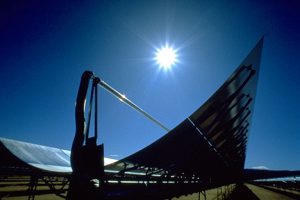DESERTEC: Clean Power From Deserts
By Michael Düren
 Solar power from deserts can contribute significantly to a future renewable energy system. The technically accessible solar potential in deserts exceeds the global energy demand by a factor of 20. In the DESERTEC concept, a smart super grid based on HVDC technology interconnects wind, solar and other renewable energy sources with distant consumers on a scale of several thousand kilometres. The large grid averages out the natural fluctuations of renewable energy sources to a large extend. A large-scale production of solar energy in desert countries has important socio-economic implications. The interconnection of continents by large power grids introduces new economical interdependencies, which can help to reduce the North-South gradient of economic wealth.
Solar power from deserts can contribute significantly to a future renewable energy system. The technically accessible solar potential in deserts exceeds the global energy demand by a factor of 20. In the DESERTEC concept, a smart super grid based on HVDC technology interconnects wind, solar and other renewable energy sources with distant consumers on a scale of several thousand kilometres. The large grid averages out the natural fluctuations of renewable energy sources to a large extend. A large-scale production of solar energy in desert countries has important socio-economic implications. The interconnection of continents by large power grids introduces new economical interdependencies, which can help to reduce the North-South gradient of economic wealth.
Abundant Solar Power
For 200,000 years, mankind had a sustainable energy system, based on biomass, wind, sun and water for cooking, heating, mobility and mechanical work. 250 years ago, during the period of industrialization, fossil fuels became available at large scale, and today, they cover 85% of the worldenergy system. The abundant solar power that is available in the deserts of the world can play a key role for a future renewable energy supply. The “clean power from deserts” or “DESERTEC” concept is an inherently international, transcontinental approach, where the central technical starting point is a super grid that distributes electric power over distances of thousands of kilometres and averages out fluctuations of the renewable sources as well as of the energy consumption. The challenge to replace coal, oil and gas also in the non-electricity sector is often forgotten in the public discussion about local renewable energy systems.
“The world is facing an increasing world population and an increasing energy demand per capita…”
Mission Impossible – the IncreasingWorld Power Demand
Today, the world power consumption is approximately 15,000GW, averaged over day and night and over the whole year. The world is facing an increasing world population and an increasing energy demand per capita, what may lead to an expected global power demand of approximately 24,000 GW in 2050. Figure 1 illustrates how the primary power divides into fossil, nuclear and renewable energies. Taking the climate goals serious, the fossil contribution has to be reduced by at least 50% in the coming decades to have an significant effect on the accumulated CO2 at all. This means that capacities of 15,000 GW of primary power have to be newly installed without exploiting the remaining fossil resources. For illustration, one should keep in mind that 1 GW corresponds to the electrical power of one nuclear power plant. To build and run 15,000 additional nuclear power plants (fission or fusion) in the next 40 years (i.e. 1 new reactors per day) is simply impossible from the point of view of the qualified manpower that is needed to do so.
The Future is Electric
If fossil fuels are drastically reduced in future, they will have to be replaced by other energy carriers. Options are synthetic fuels (liquid, or gaseous like hydrogen), or electricity. Electric power is a prime choice, as the transport and distribution of electric power is very efficient and simple and the demand of electric power by the consumer is increasing.
“… the technically accessible power exceeds the world energy consumption by a factor of 20.”
The Solar Potential in Deserts
The total solar irradiation in the deserts of the world is immense. Using current technology of thermal concentrated solar power plants (CSP), the technically accessible power exceeds the world energy consumption by a factor of 20. Figure 2 shows a map of those desert areas that are well suited for standard CSP technology. Overlaid is a satellite photo of the earth at night. The yellow lights indicate areas where there is a high consumption of electricity at night. It illustrates the concentration of electrical power consumptions in the USA, Europe and Japan and also the lack of electrical power in the populated areas of Africa and South America.

Figure 2. The red colour indicates desert areas that are well suited for solar power plants due to large direct solar irradiation. Overlaid is a satellite image of the earth at night. The yellow lights indicate the areas with concentrated electricity consumption (Source: DESERTEC; based on data from NASA and DLR). Click to enlarge.
Solar Power Plants in Deserts
There are two competing technologies (PV – photovoltaic and CSP – concentrated solar power plants) available for converting solar radiation into electricity. The CSP systems consist of a mirror system that follows the position of the sun, an absorber that converts the solar radiation into heat and a steam engine with generator that converts the heat into electricity.
The Parabolic Trough
There are several technological realizations for CSP. The most mature one uses a parabolic trough that follows the position of the sun by a one-axis rotation. It focuses the solar radiation in one dimension onto an absorber pipe.
The absorber pipe has the purpose to absorb light and to convert it into heat. The absorber pipe is usually made from special, double walled glass with a vacuum in between (like a thermos jug), to minimize heat dissipation. The inner part of the absorber pipe has a special coating which absorbs light but has a small radiant emittance in the infrared to minimize losses by heat radiation. The absorber pipe has to resist large heat loads and steep temperature gradients, e.g. when a cloud is passing. The thermal power is transported to the steam engine by a liquid. Standard technology uses a heat transfer oil at temperatures up to 400°C. Newer power plants directly evaporate water at high pressure and reach temperatures above 500°C. Here the technological challenges are the phase transition and the high pressure of the vapour. Some plants have parts of their mirror fields at different temperatures to optimize temperature and heat emission at the same time.
The steam engine with a generator converts thermal energy into mechanical and electrical power. According to the laws of thermodynamics, its efficiency depends on the temperature difference between the incoming steam and the outgoing water. To optimize the efficiency, most steam turbines use water-cooling. For desert use air condensers are needed that have a closed-circuit water-cooling system, leading to a loss of about 10% of efficiency compared to water-cooled systems. An alternative to air-cooling is cooling with seawater.
Parabolic trough systems are a proved, mature technology. Commercial systems have been operational in the desert for over 25 years in a reliable way. Prominent examples are the SEGS plants in the Mojave Desert in California, USA. CSP power plants use components that can, to a large extent, be produced in desert countries themselves. The materials used are mainly glass, steal, concrete and copper and those are sufficiently available on the world market, also for large-scale production. The energy repayment period of a parabolic trough system is 5–6 months for a location in Spain and shorter in sites of higher solar irradiation as e.g. in North Africa.
The Power Tower
While the parabolic trough and Fresnel systems focus the sunlight in one dimension, power towers focus in two dimensions and can therefore reach higher temperatures and higher Carnot efficiencies. Higher temperatures also mean a more efficient heat storage. The technology of power towers is very promising for the future, but currently there is little commercial experience, as only very few power stations are in operation. One big advantage of the power tower compared to the parabolic trough is that the power tower can be built in a hilly area whereas the parabolic trough needs a flat surface. The heat carriers that have been investigated are steam, liquid sodium, and others. The research tower in Jülich/Germany uses ambient air that is aspirated through the absorber.
CSP offers a largely unexplored field to synthesize gaseous and liquid fuels using catalytic reactions at high temperatures. A prominent example is the generation of alcohol using synthesis gas that is generated in a solar tower from CO2 and water.
Click ‘Play’ to see Professor Michael Düren of DESERTEC argue that we can harness the African desert sun to power the world:
Thermal Storage Using Molten Salt
Solar thermal power stations use heat as intermediate energy medium and allow for a cost effective storage of energy at large scale. First commercial systems are operated that combine a parabolic trough power plant with a large-scale storage capacity using molten salt as storage medium. During the day the molten salt from the “cold” container is pumped into the “hot” container using a heat exchanger that transfers the thermal energy from the thermo oil coming from the solar mirror field to the molten salt. After sunset the salt is pumped back to the original container through a heat exchanger that gives the energy to the steam system. This way the steam turbine can continue to operate during night. In the commercial systems in Spain the size of the heat storage is optimized to deliver electricity during the evening peak hours. The investment of the heat storage system pays off for two reasons: it allows an electricity production on demand when the electricity price is highest and it allows to operate the steam turbine at full load for a longer time every day without having to cut the solar peak power during midday.
Hybrid Power Stations
As CSP power stations use conventional steam turbines, one can combine solar power and fossil power in the same power plant without doubling the investments for the power block. Even though CSP stations with heat storage can deliver power day and night, there may be reasons to operate a CSP station with fossil fuels, e.g. to bridge a bad weather period.
Another reason for building hybrid power stations is to minimize initial investments. Starting from an existing modern combined cycle gas turbine, the fossil fuel can be replaced by solar energy step-by-step by adding a solar field that delivers part of the exergy.
The fossil water sources are limited and the demand for water is increasing due to the population rise.
Seawater Desalination in Desert Countries
For many desert countries the future fresh water supply is an even more serious issue than the energy supply. Today, many desert countries exploit fossil water reservoirs for drinking water and for agriculture. The fossil water sources are limited and the demand for water is increasing due to the population rise. The problem may be intensified in future by reduced rainfalls due to climate changes, especially in many regions of Africa. Seawater desalination can mitigate the problem. As seawater desalination is inherently energy intensive, it is important to integrate seawater desalination into an overall energy concept. An elegant way to combine electricity production and seawater desalination is to use the waste heat of CSP stations for desalination.
Wind Power in Deserts and Off-Shore
In many desert countries there are trade winds that allow for an efficient and reliable production of wind power. Modern wind power stations are a highly cost efficient way to produce renewable energies. Due to the fluctuating nature of wind, wind power has to be integrated into a large grid to average out fluctuations and it has to be combined with other sources of renewable energy in a common concept. Naturally, wind energy is not limited to deserts. There is a large unused energy potential offshore that is waiting to be harvested. Wind power increases with the third power of the wind speed, and therefore offshore wind power is significantly larger than on-shore wind power. What the desert is for solar energy, the sea is for wind energy.
The Ideal Solar Thermal Power Station
To summarize, the ideal solar thermal power station in the desert focuses the light by a large concentration factor, reaches highest temperatures, stores the heat using a large volume of cheap storage material, and uses the stored heat to produce electricity on demand.The waste heat is used for seawater desalination and as process heat for industrial processes.
Power to the People – the Super Grid
The electric power produced in deserts has to fulfil first the growing power demand of the local population in the desert country. The large potential will exceed the local demand by far and can be used to export electrical power to the neighbouring countries. By the use of a super grid that spans continents, all kind of distant, renewable energy sources can be interconnected among each other and with the consumers.
The idea of DESERTEC is to interconnect the local grids on a scale of thousands of kilometres for three reasons: to transport energy from deserts to distant consumers, to average out fluctuations of renewable energy sources, and to minimize expensive local storage and backup capacities.
HVDC Technology
The super grid became feasible by recent progress in the technology of high voltage direct currents (HVDC) which is needed for long distance transmission and allows for point to point connections with small power losses.
Averaging out Fluctuations
Sun and wind are fluctuating energy sources. The sun has a daily and a yearly cycle, and due to clouds and weather conditions there is a stochastic behaviour in addition to the predictable oscillations. For wind energy the stochastic fluctuations dominate the cyclic variations. The fluctuations are spatially correlated, and the correlations decrease with distance. By interconnecting a large number of fluctuating energy sources, part of the fluctuations are averaged out.
Demand Control – Smart grids do not only adjust the production to the consumption, but in addition they adjust the power consumption to the availability of power.
Energy Security
Energy has to be available 24h per day, every day in the year. Our current fossil energy system based on coal, oil and gas uses storage capacities to ensure permanent availability. In the electricity sector, today’s base load power stations fired by coal and nuclear energy are supplemented by gas and oil power stations to account for peak hours of electricity demand. If in future a major fraction of the electrical power comes from sun and wind, the fluctuations and the daily and yearly cycles of these renewable energy sources have to be taken into account for a secure energy supply. The main ingredients for a stable, renewable energy supply based on energy from deserts are:
- A large-scale smart super grid
- CSP thermal storage
- Overcapacities and a “fine-tuning” of the selection of various power sources
- Large scale water pump storage
- Power to gas production
- Back-up power stations
Environmental Issues
The apparent (relative) cost advantage of fossil and nuclear energies are deceptive and caused by not internalising external costs.
Numerous large-scale solar power stations, wind parks, overhead lines, and large pump storage stations certainly have an impact on the environment that has to be carefully studied. Nevertheless, all conceivable impacts of this renewable energy concept are put into perspective compared to the impact of global warming, air pollution, oil pollution, nuclear accidents, or coal and uranium mining and radioactive waste repositories.
The Learning Curve and the Internalization of External Costs
The change of our global energy system requires huge investments. Conventional power plants, like e.g. gas turbines, need a comparably small initial investment, and a large proportion of the electricity costs comes from the costs of the fossil fuel. Renewable energy systems have small running costs and the major part of the electricity costs are investment costs, i.e. manpower and material during construction and the interest of the investor. In addition, there is a learning curve to pay in the coming years, as the required technologies are partially still in the precommercial development phase and not yet in mass production. All that makes the switch from an exploiting energy system to a renewable energy system economically difficult, and political regulations or incentives are needed so that renewable energies can compete with the old technologies on a free market. Possible political tools are feed-in tariffs, carbon certificate trading or energy taxes. A first and overdue measure is the cancellation of governmental subsidies for the mining or use of fossil fuels. A more difficult step is the internalization of the external costs.
Examples for external costs of fossil fuels are the long-term costs of global warming, the costs of air pollution to the health of the population and the costs of oil pollution by accidents during drilling and transport of the oil. Examples for external costs of nuclear industry are the long term costs of nuclear accidents, the costs for keeping nuclear radioactive waste repositories safe over centuries and the costs to prevent the proliferation of nuclear weapons. A first political measure to bring the old and the renewable energy industries to an equal footing would be to force energy companies to re-insure those risks. A full risk assessment and insurance against costs of possible terroristic attacks in nuclear industry would certainly make nuclear power economically unattractive. The same will be true for oil and coal companies if the impact of global warming is internalized.
It can be predicted that even without internalizing external costs and without special feed-in tariffs, wind, CSP and PV power stations will be economically competitive in many areas of the world in the coming decades, due to the rising costs of fossil fuels and due to the cost reduction by mass production of components for renewable energy power stations. This fact makes investments in new fossil or nuclear power stations uncertain already today, as a power station that is constructed today will not be competitive during its whole life span any more. In addition, future investments in fossil and nuclear industry will face an increasing risk of penalties (taxes, re-insurance, environmental conditions, etc.) due to the decreasing acceptance in the public opinion. Therefore, feed-in-tariffs and other political measures are not needed to make the energy revolution happen, but they are urgently needed to make the energy revolution happen in time, i.e. before humanity runs into serious problems of energy shortage and climate change.
The Special Situation of MENA and Europe
In MENA (Middle East and North Africa) the population and the need for electricity are growing rapidly. There is little industry in North Africa, a high unemployment rate and a lack of prospects for the young generation. The idea of DESERTEC is to construct solar and wind power stations in MENA. The excess of energy that is not needed in the country itself can be exported to Europe. That creates an economical interdependence between MENA and Europe and is a basis for a stronger future collaboration. It is a classical win-win situation. Europe has the knowledge how to build the power plants and the HVDC grid. It also has the money to pay for the learning curve. MENA has the optimum sites for solar energy power stations and the manpower to construct them. Europe can profit from a cost-effective clean solar power generation, from a political stabilization of North Africa due to the economic growth, and from a new business market in its vicinity. The rising problem of migration and extremism can be mitigated by a close collaboration of Europe and Africa.
The rising problem of migration and extremism can be mitigated by a close collaboration of Europe and Africa.
Africa has the advantage of getting sustainable energy, fresh water from seawater desalination, new possibilities for industrial growth and a large number of new jobs and perspectives for the future of the young population. The power connection of the continents can bring the continents closer together in an economical and may be even in a cultural way. Representatives from North-Africa have expressed that they do NOT want turnkey power stations made by European companies any more, but that they want to gain the know-how themselves how to build solar power stations and have local value added. The DESERTEC foundation supports this concept and has set up an academic and a university network where institutes from most of the North African countries are represented. A large number of (local) engineers is required, so that the goal to build a large amount of power stations in the coming decades can happen sufficiently fast.
DESERTEC Ready to Go
Clean power from deserts is ready to go. It has an overwhelming potential for a sustainable world energy supply. Basic concepts and technologies are available to be implemented. Nevertheless, the way to an almost 100% renewable, carbon free energy supply still requires huge efforts of technical R&D, and more important, significant changes in the political and socio-economic boundary conditions. Looking at today’s economical and political decisions, it seems that many people either ignore or underestimate the range of the required changes of the world energy system.
Source: Edited excerpts from “Clean Power from Deserts” paper (October 2011) by Michael Düren.
About the Author
Michael Düren studied Physics at the RWTH in Aachen, Germany and obtained his PhD in 1987 in the field of particle physics. After being a postdoc at the Max-Planck-Institute for Nuclear Physics in Heidelberg,he habiltated at the University Erlangen-Nürnberg, was interim professor at the University Bayreuth and, since 2001, he is full professor for experimental physics at the JLU Giessen. Since 1988, he is member of the Energy Working Group at the German Physics Society. In 2006, he was co-founder of the interdisciplinary SEPA working group (Solar Energy Partnership Africa-Europe) at the Univ. Giessen and in 2008 co-founder of the DESERTEC foundation. Since July 2011, he is coordinator of the DESERTEC Academic Network.
About DESERTEC
 The DESERTEC Foundation is a global civil society initiative aiming to shape a sustainable future. It was established on 20 January 2009 as a non-profit foundation that grew out of a network of scientists, politicians and economists from around the Mediterranean, who together developed the DESERTEC Concept. Founding members of DESERTEC Foundation are the German Association of the Club of Rome, members of the international network as well as committed private individuals.
The DESERTEC Foundation is a global civil society initiative aiming to shape a sustainable future. It was established on 20 January 2009 as a non-profit foundation that grew out of a network of scientists, politicians and economists from around the Mediterranean, who together developed the DESERTEC Concept. Founding members of DESERTEC Foundation are the German Association of the Club of Rome, members of the international network as well as committed private individuals.
SEPA-DESERTEC International Conference 2012
You may have an interest in also reading…
LegalOne: Driving Innovation and Financial Inclusion for National Development
LegalOne Global Limited has established itself as a trusted authority in independent ratings and business intelligence, delivering rigorous research and
From Local Strength to Continental Success: BAWAG’s Steady Expansion in Europe
BAWAG Group has emerged as one of Europe’s most efficient and profitable banking institutions, founded on a clear ambition: to
Investing in a Future that has Never Seemed Brighter — a True Pioneer Bank in Mongolia
Staying true to its values and aims has taken Golomt Bank to enviable heights. Golomt Bank was established on 1995























































































